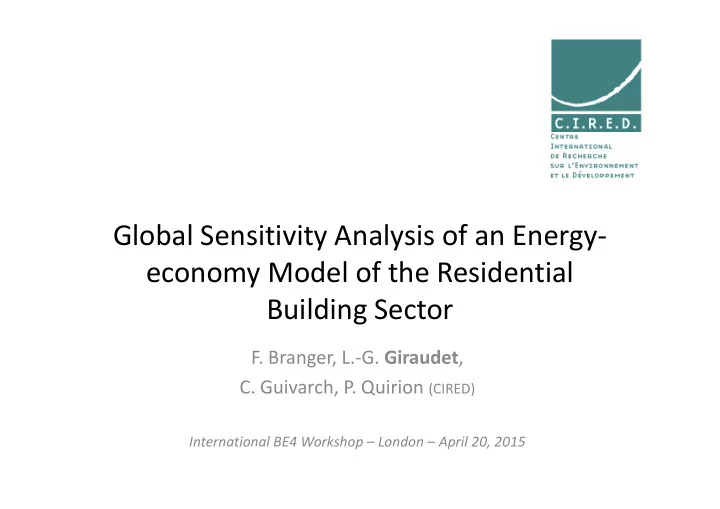

Global Sensitivity Analysis of an Energy- economy Model of the Residential economy Model of the Residential Building Sector F. Branger, L.-G. Giraudet , C. Guivarch, P. Quirion (CIRED) International BE4 Workshop – London – April 20, 2015
Households Energy services Firms Installers / Retailers / Manufacturers Insulation Space Heating heating system Water Lamps heating Income class Appliances Tenure type Tenure type Lighting Lighting etc. Type of dwelling Energy durables etc. Cooking Electricity Electrical & electronical uses Natural gas Fuel oil Energy Suppliers / Distributors / Producers Institutional framework 2
� Uncertainty associated with modelling such a complex system? 1. The Res-IRF model in a nutshell 2. Quantifying uncertainty: Monte-Carlo 2. Quantifying uncertainty: Monte-Carlo analysis 3. Characterizing uncertainty: the Morris Method 3
Res-IRF in a nutshell
Res Res- -IRF: Scope IRF: Scope • Energy use covered – Space heating (2/3 of French household demand) – Electricity, natural gas, fuel oil • Energy efficiency improvements • Energy efficiency improvements – New constructions (standard/low energy/passive) – Retrofitting of existing dwellings (including fuel switch) G F E D C B A G F E D C B A 5
Res Res- -IRF’s Main Innovations IRF’s Main Innovations • All margins of energy use are endogenous – Intensity of retrofits – Number of retrofits – Utilization adjustments (Rebound effect) – Utilization adjustments (Rebound effect) • Some barriers to energy efficiency – Static: split incentives (discount rates) – Dynamic: learning-by-doing, information acceleration 6
Intensity Intensity of of Retrofits Retrofits − ν LCC = ∑ , i f PR Heterogeneous discount , i f − ν LCC rates across landlords and , i h > h i tenants = + + LCC CINV CENER IC , , , i f i f f i f Subject to endogenous Subject to endogenous decrease (peer effects) decrease (learning-by-doing) 7
Number of Retrofits Number of Retrofits Captures heterogeneity in preferences for heating (e.g. sensitiveness to cold) 8
9 Data: EDF R&D (see Cayre et al t al., 2011, ECEEE Proceedings) Utilization Adjustments Adjustments Elasticity -0.5 Utilization
Insights into French Policy Insights into French Policy €200/tCO 2 in 2010!!! France’s Target -38% 10
Quantifying Uncertainty: Monte-Carlo Analysis Monte-Carlo Analysis
Protocol Protocol Randomly pick parameters parameters Latin Hypercube Sampling 12
Overall Uncertainty Overall Uncertainty 25% around the median value 13
Characterizing Uncertainty: the Morris Method the Morris Method
Methods of Sensitivity Analysis Methods of Sensitivity Analysis Computational cost Sobol Morris (a.k.a. Morris (a.k.a. Elementary effects) One-at- a-time Local analysis Global analysis 15
The Morris Method: Design The Morris Method: Design 3 k+1 simulations � k elementary effects 2 1 We repeat the operation for r trajectories Parameters space � r*(k+1) simulations 16
Results: Morris Diagram Results: Morris Diagram Measure of interaction Most interacting Most influential Measure of influence 17
Parameters Ranking Parameters Ranking 18
Important Parameters: Comment Important Parameters: Comment • Energy price Somewhat reassuring that the model is sensitive to its main input…but very uncertain parameter in practice! • Initial retrofitting rate • Initial retrofitting rate Illustrates that calibration is a critical step • Rebound effect elasticity Importance of behaviours The model is more sensitive to how the different margins of energy use are disaggregated than to how barriers to energy efficiency are introduced 19
Discussion Discussion Overall, we were quite happy with the results. But… • Even though all inputs are taken into account, analysis still dependent on the choice of the probability distributions distributions • Sensitivity specific to one particular output (energy use) • Sensitivity analysis only captures uncertainty about model quantities, not about model forms 20
REFERENCES REFERENCES - Branger et al. (2015) Global sensitivity analysis of an energy-economy model of the residential building sector, forthcoming, Envionmental Modeling & Software - Giraudet et al. (2011). Comparing and combining energy saving policies. Will proposed residential sector policies meet french official targets? Energy Journal, 32 (SI 1):213–242 Energy Journal, 32 (SI 1):213–242 - Giraudet et al. (2012). Exploring the potential for energy conservation in french households through hybrid modeling. Energy Economics, 34 (2):426–445. - Morris, M. D. (1991). Factorial sampling plans for preliminary computational experiments. Technometrics, 33(2):161–174. - Saltelli et al (2008). Global Sensitivity Analysis: The Primer. John Wiley & Sons. - Van Asselt, M. B. A. and Rotmans , J. (2002). Uncertainty in integrated assessment modelling. Climatic Change, 54(1):75–105.
Potential for energy conservation in French dwellings Potential for energy conservation in French dwellings Reference savings: -37% « Rebound » gap: -10% « Private efficiency » gap: -4% « Social efficiency » gap: -8% Giraudet, L.-G., Guivarch, C., Quirion, P., 2012. Exploring the potential for energy conservation in French households through hybrid modeling. Energy Economics 34, 426–445. doi:10.1016/j.eneco.2011.07.010 22
Recommend
More recommend